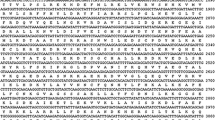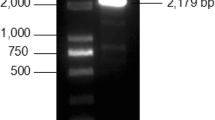Abstract
D53 is a crucial gene involved in tillering regulation in crops via the strigolactone signaling pathway. The objective of our research was to clone the homologous sugarcane (Saccharum L. spp. hybrids) gene of D53 (ScD53) by in silico cloning combined with RT-PCR and rapid amplification of cDNA ends techniques, and the physicochemical properties and structure of ScD53 protein were analyzed using bioinformatic software and tools. The relationships between the expression of ScD53 and some plant hormones, bud germination and tillering occurrence of seedlings were also detected using the real-time fluorescence quantitative PCR (FQ-PCR) technique. The homolog was named ScD53 and possessed a 3918-bp cDNA sequence. Bioinformatic analysis showed that ScD53 has a complete open reading frame of 3363 bp that encodes 1120 amino acid residues. The ScD53 protein possesses the conserved domain of the P-loop NTPase and ClpB_D2-small superfamilies, which may be unstable hydrophilic proteins and are likely to be located in the nucleus. The main secondary and tertiary structures of the ScD53 protein are composed of random coil and alpha helix structures and exhibit high similarity in structure and homology with D53 proteins from sorghum [Sorghum bicolor (L.) Moench] and maize (Zea mays L.). The FQ-PCR results showed that the expression of ScD53 is tissue specific and is differently expressed in the different tissues. The expression of ScD53 is associated with bud germination, the high expression of which inhibits bud germination. Plant hormone treatment experiments indicated that the expressions of ScD53 were induced in bud and leaf tissues by strigolactones, 3-indole acetic acid and kinetin (KT, a cytokinin analog). The high expression of ScD53 following strigolactone and auxin treatment obviously delayed occurrence of tillers and reduced the number of tillers for the seedlings. However, this was not observed during KT treatment, which implied that the negative effects of this gene on seedlings tillering phenotype were eliminated by the positive influences of other unknown pathways. Our results above help elucidate the function of ScD53 and provide important information and direction for the use of this gene in improving sugarcane yield through tiller regulation.








Similar content being viewed by others
References
Arite, T., H. Iwata, K. Ohshima, M. Maekawa, M. Nakajima, M. Kojima, H. Sakakibara, and J. Kyozuka. 2007. DWARF10, an RMS1/MAX4/DAD1 ortholog, controls lateral bud outgrowth in rice. Plant Journal 51(6): 1019–1029.
Arite, T., M. Umehara, S. Ishikawa, A. Hanada, M. Maekawa, S. Yamaguchi, and J. Kyozuka. 2009. d14, a strigolactone-insensitive mutant of rice, shows an accelerated outgrowth of tillers. Plant and Cell Physiology 50(8): 1416–1424.
Booker, J., M. Auldridge, S. Wills, D. McCarty, H. Klee, and O. Leyser. 2004. MAX3/CCD7 is a carotenoid cleavage dioxygenase required for the synthesis of a novel plant signaling molecule. Current Biology 14(14): 1232–1238.
Brewer, P.B., E.A. Dun, B.J. Ferguson, C. Rameau, and C.A. Beveridge. 2009. Strigolactone acts downstream of auxin to regulate bud outgrowth in pea and Arabidopsis. Plant Physiology 150(1): 482–493.
Brewer, P.B., H. Koltai, and C.A. Beveridge. 2013. Diverse roles of strigolactones in plant development. Molecular Plant 6(1): 18–28.
Chen, D.W., Y. Huang, Y.L. Lu, Y. Jiang, and Q.W. Li. 2013. Effect of different nutrient solutions on the growth of sugarcane tissue culture seedlings. Guangdong Agricultural Science 40(21): 28–31.
Cook, C.E., L.P. Whichard, W.E. Monroe, G.H. Egley, P. Coggon, P.A. Luhan, and A.T. Mcphail. 1972. Germination stimulants. II. Structure of strigol, a potent seed germination stimulant for witchweed (Striga lutea). Journal of the American Chemical Society 94(17): 6198–6199.
Cook, C.E., L.P. Whichard, B. Turner, M.E. Wall, and G.H. Egley. 1966. Germination of witchweed (Striga lutea L.): Isolation and properties of a potent stimulant. Science 154(3753): 1189–1190.
Drummond, R.S.M., N.M. Martínez-Sánchez, B.J. Janssen, K.R. Templeton, J.L. Simons, B.D. Quinn, S. Karunairetnam, and K.C. Snowden. 2009. Petunia hybrida CAROTENOID CLEAVAGE DIOXYGENASE7 is involved in the production of negative and positive branching signals in petunia. Plant Physiology 151(4): 1867–1877.
Dun, E.A., P.B. Brewer, and C.A. Beveridge. 2009. Strigolactones: Discovery of the elusive shoot branching hormone. Trends in Plant Science 14(7): 364–372.
Durbak, A., H. Yao, and P. Mcsteen. 2012. Hormone signaling in plant development. Current Opinion in Plant Biology 15(1): 92–96.
Fen, D., and G.L. Chen. 2011. Shoot-branching control with strigolactones: Research progress. Chinese Journal of Ecology 30(2): 349–356.
Foo, E., E. Bullier, M. Goussot, F. Foucher, C. Rameau, and C.A. Beveridge. 2005. The branching gene RAMOSUS1 mediates interactions among two novel signals and auxin in pea. Plant Cell 17(2): 464–474.
Gallavotti, A., Y. Yang, R.J. Schmidt, and D. Jackson. 2008. The relationship between auxin transport and maize branching. Plant Physiology 147(4): 1913.
Gao, Y., Y. Li, Y.F. Xie, and Y.K. Liu. 2013. Research progress on molecular mechanism of strigolactones in regulating of plant lateral shoot development and its interaction with auxin. Journal of Plant Resources and Environment 22(4): 98–104.
Gao, Z., Q. Qian, X. Liu, M. Yan, F. Qi, G. Dong, L. Jian, and B. Han. 2009. Dwarf 88, a novel putative esterase gene affecting architecture of rice plant. Plant Molecular Biology 71(3): 265–276.
Gomez-Roldan, V., S. Fermas, P.B. Brewer, V. Puech-Pagès, E.A. Dun, J.P. Pillot, F. Letisse, R. Matusova, S. Danoun, J.C. Portais, H. Bouwmeester, G. Bécard, C.A. Beveridge, C. Rameau, and S.F. Rochange. 2008. Strigolactone inhibition of shoot branching. Nature 455(7210): 189–194.
Ishikawa, S., M. Maekawa, T. Arite, K. Onishi, I. Takamure, and J. Kyozuka. 2005. Suppression of tiller bud activity in tillering dwarf mutants of rice. Plant and Cell Physiology 46(1): 79–86.
Jiang, L., X. Liu, G. Xiong, H. Liu, F. Chen, L. Wang, X. Meng, G. Liu, H. Yu, and Y. Yuan. 2013. DWARF 53 acts as a repressor of strigolactone signalling in rice. Nature 504(7480): 401.
Kebrom, T.H. 2017. A Growing stem inhibits bud outgrowth-the overlooked theory of apical dominance. Frontiers in Plant Science 8: 1874.
Kumar, S., G. Stecher, and K. Tamura. 2016. MEGA7: Molecular evolutionary genetics analysis version 7.0 for bigger datasets. Molecular Biology and Evolution 33(7): 1870.
Kyozuka, J. 2007. Control of shoot and root meristem function by cytokinin. Current Opinion Plant Biology 10(5): 442–446.
Lee, T.S.G., and E.A. Bressan. 2006. The potential of ethanol production from sugarcane in Brazil. Sugar Tech 8(4): 195–198.
Leyser, O. 2003. Regulation of shoot branching by auxin. Trends in Plant Science 8(11): 541–545.
Li, S.J., J. Gao, J.Y. Li, and Y.H. Wang. 2015a. Advances in regulating rice tillers by strigolactones. Chinese Bulletin of Botany 50(5): 539–548.
Li, X.J., X.Q. Lin, H.B. Liu, C.J. Chun, C.H. Xu, and X.L. Liu. 2015b. Clone and bioinformatics analysis of the TB1 gene in sugarcane. Chinese Journal of Tropical Crops 36(11): 1978–1985.
Li, W.C., J.W. Wang, and J.J. Yu. 2012. Research overview of the tillering gene in rice. Crops 3: 19–22.
Li, Y.R., and Y.A. Wei. 2006. Sugar industry in china: R&D and policy initiatives to meet sugar and biofuel demand of future. Sugar Tech 8(4): 203.
Lin, H., R. Wang, Q. Qian, M. Yan, X. Meng, Z. Fu, C. Yan, B. Jiang, Z. Su, J. Li, and Y. Wang. 2009. DWARF27, an iron-containing protein required for the biosynthesis of strigolactones, regulates rice tiller bud outgrowth. Plant Cell 21(5): 1512–1525.
Ling, H., Q. Wu, J. Guo, L. Xu, and Y. Que. 2014. Comprehensive selection of reference genes for gene expression normalization in sugarcane by real time quantitative RT-PCR. PLoS ONE 9(5): e97469.
Liu, X.H., R.H. Zhang, Y.Y. Gui, X.Q. Zhang, J.J. Wei, H. Zhou, H.P. Ou, and X.L. Liu. 2017. Cloning and bioinformatics analysis of tillering-related gene NpD53 from Narenga porphyrocoma (Hance) Bor. Journal of Southern Agriculture 48(9): 1554–1559.
Livak, K.J., and T.D. Schmittgen. 2001. Analysis of relative gene expression data using real-time quantitative PCR and the 2−ΔΔCT method. Methods 25(4): 402–408.
Mcsteen, P. 2009. Hormonal regulation of branching in grasses. Plant Physiology 149(1): 46–55.
Mikihisa, U., H. Atsushi, Y. Satoko, A. Kohki, A. Tomotsugu, T.K. Noriko, M. Hiroshi, K. Yuji, S. Ken, and Y. Koichi. 2008. Inhibition of shoot branching by new terpenoid plant hormones. Nature 455 (7210): 195–200.
Rameau, C., J. Bertheloot, N. Leduc, B. Andrieu, F. Foucher, and S. Sakr. 2015. Multiple pathways regulate shoot branching. Frontiers in Plant Science 5: 741.
Rashotte, A.M., S.D. Carson, J.P. To, and J.J. Kieber. 2003. Expression profiling of cytokinin action in arabidopsis. Plant Physiology 132(4): 1998–2011.
Shani, E., O. Yanai, and N. Ori. 2006. The role of hormones in shoot apical meristem function. Current Opinion Plant Biology 9(5): 484.
Snowden, K.C., A.J. Simkin, B.J. Janssen, K.R. Templeton, H.M. Loucas, J.L. Simons, S. Karunairetum, A.P. Gleave, D.G. Clark, and H.J. Klee. 2005. The decreased apical dominance1/Petunia hybrida CAROTENOID CLEAVAGE DIOXYGENASE 8 gene affects branch production and plays a role in leaf senescence, root growth and flower development. Plant Cell 17(3): 746–759.
Sorefan, K., J. Booker, K. Haurogne, M. Goussot, K. Bainbridge, E. Foo, S.P. Chatfield, S. Ward, C.A. Beveridge, C. Rameau, and O. Leyser. 2003. MAX4 and RMS1 are orthologous dioxygenase-like genes that regulate shoot branching in Arabidopsis and pea. Genes & Development 17(12): 1469–1474.
Soundappan, I., T. Bennett, N. Morffy, Y. Liang, J.P. Stanga, A. Abbas, O. Leyser, and D.C. Nelson. 2015. Smax1-like/d53 family members enable distinct max2-dependent responses to strigolactones and karrikins in arabidopsis. Plant Cell 27(11): 3143.
Stanga, J.P., S.M. Smith, W.R. Briggs, and D.C. Nelson. 2013. SUPPRESSOR OF MORE AXILLARY GROWTH2 1 controls seed germination and seedling development in Arabidopsis. Plant Physiology 163(1): 318–330.
Stirnberg, P., K. van de Sande, and H.M.O. Leyser. 2002. MAX1 and MAX2 control shoot lateral branching in Arabidopsis. Development 129(5): 1131–1141.
Tanaka, M., K. Takei, M. Kojima, H. Sakakibara, and H. Mori. 2006. Auxin controls local cytokinin biosynthesis in the nodal stem in apical dominance. Plant Journal for Cell & Molecular Biology 45(6): 1028–1036.
Umehara, M., A. Hanada, S. Yoshida, K. Akiyama, T. Arite, N. Takeda-Kamiya, H. Magome, Y. Kamiya, K. Shirasu, K. Yoneyama, J. Kyozuka, and S. Yamaguchi. 2008. Inhibition of shoot branching by new terpenoid plant hormones. Nature 455(7210): 195–200.
Vasantha, S., D.E. Shekinah, C. Gupta, and P. Rakkiyappan. 2012. Tiller production, regulation and senescence in sugarcane (Saccharum species hybrid) genotypes. Sugar Tech 14(2): 156–160.
Wang, M., H.W. Chen, H.L. Chen, and K.F. Liu. 2014. Research progress in regulatory role of strigolactones in shoot branching. Acta Horticulturae Sinica 41(9): 1924–1934.
Wang, L., B. Wang, L. Jiang, X. Liu, X. Li, Z. Lu, X. Meng, Y. Wang, S.M. Smith, and J. Li. 2015. Strigolactone signaling in Arabidopsis regulates shoot development by targeting D53-Like SMXL repressor proteins for ubiquitination and degradation. Plant Cell 27(11): 3128.
Zhou, F., Q. Lin, L. Zhu, Y. Ren, K. Zhou, N. Shabek, F. Wu, H. Mao, W. Dong, and L. Gan. 2013. D14-SCFD3-dependent degradation of D53 regulates strigolactone signalling. Nature 504(7480): 406–410.
Acknowledgements
This work was supported by the National Natural Science Foundation of China (31760412) and Candidates of the Young and Middle Aged Academic Leaders of Yunnan Province (2014HB038), and by funding from the Yunnan Provincial Science and Technology Department for High-End Talent Program. We would like to thank LetPub (www.letpub.com) and Dr. David M. Burner for editorial assistance.
Author information
Authors and Affiliations
Contributions
ALL carried out the experiment and wrote the manuscript. XJL, CJL, HBL, QYZ, XQL participated in experimental work. XLL conceived and designed the study.
Corresponding author
Ethics declarations
Conflict of interest
The authors declare no conflict of interest.
Additional information
Publisher's Note
Springer Nature remains neutral with regard to jurisdictional claims in published maps and institutional affiliations.
Rights and permissions
About this article
Cite this article
Lv, AL., Li, XJ., Li, CJ. et al. Cloning and Expression Analysis of the ScD53 Gene from Sugarcane. Sugar Tech 21, 898–908 (2019). https://doi.org/10.1007/s12355-019-00730-z
Received:
Accepted:
Published:
Issue Date:
DOI: https://doi.org/10.1007/s12355-019-00730-z




